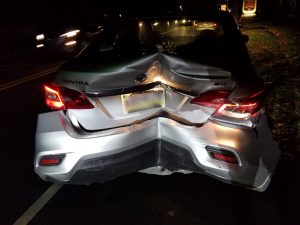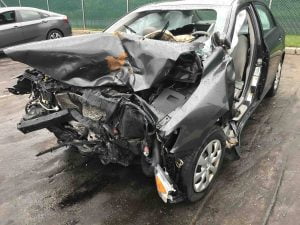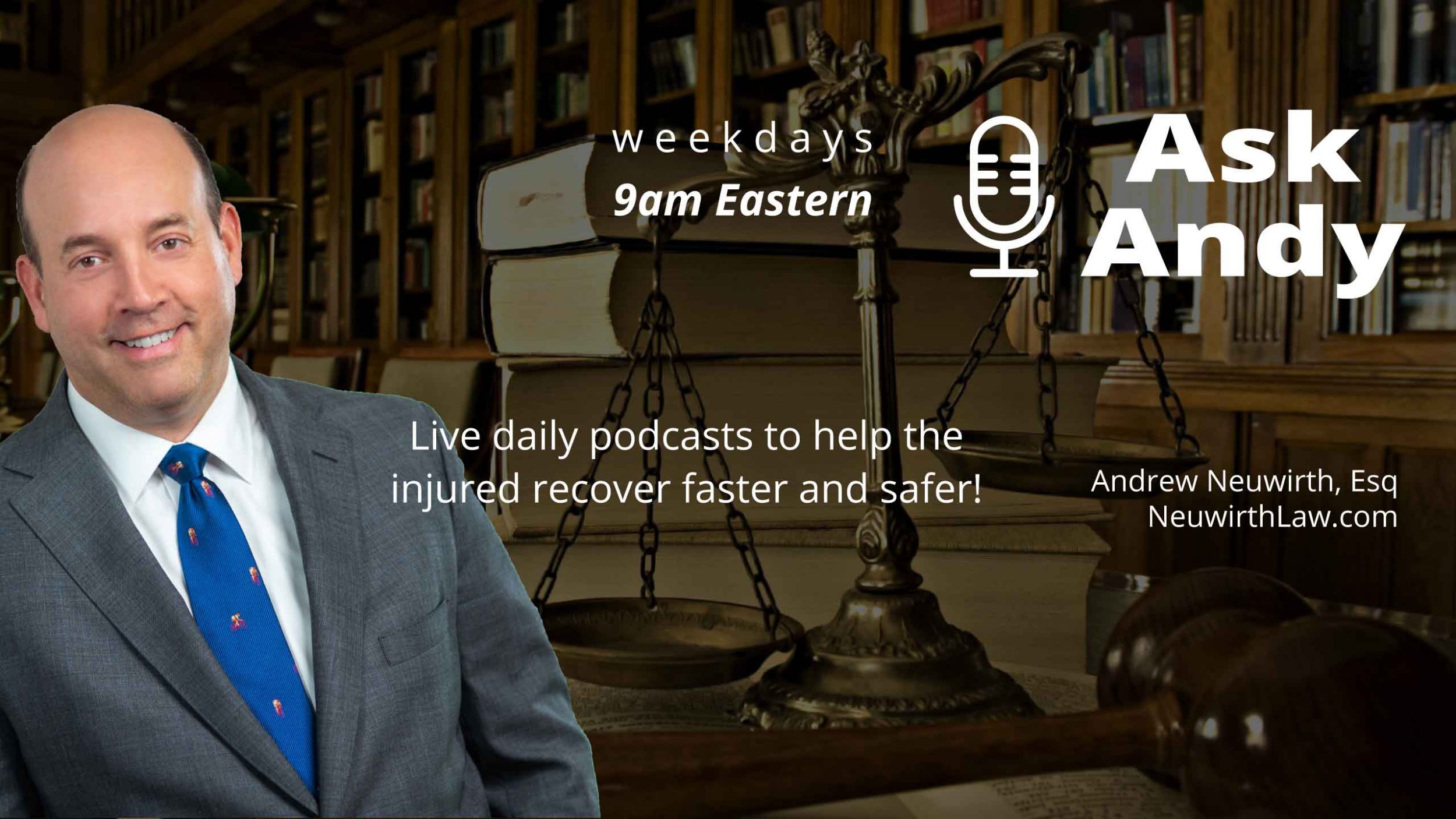Transcript
Good morning, and welcome to ask Andy, this is a daily podcast about personal injury practice in Philadelphia, Pennsylvania. I’m Andrew Neuwirth. This is not legal advice. Good morning. I wanted to talk to you about today, whether you have a case. So sometimes people call me literally from the Schuylkill Expressway, which is, you know, the highway running through the middle of Philadelphia saying I was just in an accident. Sometimes people wait a week or a month before calling. I don’t know quite, you know, the functioning of everyone’s mindset about things. Sometimes if you’re badly hurt, you pick up the phone and call a lawyer. Sometimes if you’re not, you wait a little bit. And if things don’t get better, you call a lawyer. So the question today is, you know, do you have a case? This is kind of a simple one for me and maybe a harder one for people who aren’t used to dealing with lawyers or the legal system. So let’s say you are not at fault, meaning you don’t think you’re at fault or there’s no possible way you’re at fault and you’re injured. Do you have a case? Yeah. Is it a case a lawyer is going to want to take? Not necessarily. You know, do you have a booboo? Do you have a twisted ankle? Do you have a sore wrist? Maybe, maybe not. It all depends. What about situations where so what are the easy ones? Easy ones are, you know, you’re driving along and someone runs a stop sign and hit you.
They T bone you. You’re injured, you’re rear ended. Someone crosses the line and hits your head on, or someone makes a left turn in front of you when you had a green light and they had no right to turn those. The left turn situations are a little more confusing for people because they can’t really usually imagine that scenario happening. But if you’re driving straight and someone turns across traffic in front of you, let’s say to enter a highway entrance and you’re just driving along, minding your own beeswax and you hit them, that’s still their fault. So, OK, those are the easy ones. Let’s say you weren’t really hurt in any of those cases. Do you have a case? Well, yes and no. Yes, you have a case, meaning you were not at fault. But no, you know, it’s not one that may be worth bringing, but and a lot of those situations, at least the left turn cases and the T-boned cases, most people, you know, take a pretty severe impact and they’re pretty hurt. So, you know, do you have a case? Yeah, probably. Is it worth pursuing? And here’s kind of the question. This is kind of where it’s, you know, you’ve got to step out of your own profession and place in the world, whatever you do for a living and say, you know, look, I don’t, I don’t. I’m not a professional at this. I don’t know what I’m doing. So this is kind of the sales pitch for lawyers everywhere is, Hey, look, if you’re not a lawyer, at least go to a lawyer.
You know, at least in personal injury, it’s free to talk. It’s like there’s no fee. A lot of lawyers who do employment law or do trust in the states or this or that charge for their time, meaning they charge you to, you know, initial consultation fee. I don’t do that. I don’t know any personal injury lawyer who does that because it’s really hard to give you advice until we’ve kind of heard the whole story and figured out what happened. So we just don’t. That’s not how we get paid. So look, if you’re trying to decide, do I have a case, I think the right answer from any lawyer is, I don’t know. Give us a call. Hit us up through the website. You know, email me or anyone else, and we can talk about your situation. So that’s kind of the first step is like, Look, this is not something you want to be Googling to try and figure out if you have a case or not. Or, you know, a lot of times people come to me and they and they’ve decided they don’t have a case. And that’s kind of in their own mind. But actually, they do. They just don’t have enough professional training to realize what they have. Ok, so look, don’t make up or down, yes or no decisions without consulting with a professional. Just because you talk to me and I tell you have a case doesn’t mean you’ve got to sign up and be a client.
And a lot of times I tell people like, I can’t be your lawyer. I don’t work in New Jersey or I don’t work in Delaware. So look, there’s all sorts of different parameters, but back to do. I have a case. What’s the next? So the big question is always like, were you at fault? You know, if you’re in a four way stop and everyone’s kind of waiting for the other person to go and then someone goes and they cause an accident like, you know, those cases? Yeah, maybe. Do you want to be taking them on a regular basis as a lawyer? Probably not. You know, red light green, light red, light yellow, light green light, those. Cases are not necessarily great cases, but they’re possible. Excuse me. And then the question is like what level of injury do you need to really have a case worthwhile to bring? That’s kind of backwards English. But you know, look, I handle a lot of what the general population calls soft tissue injuries, but most, if not all, of my soft tissue injury people will tell you that they’re in a lot of pain and they don’t want to be soft tissue injury clients. So look, do you need to have something broken? No. Does that make things easier for me? Yes. Do you need to have you know, something severely wrong. It just depends on your definition that’s again sort of wandering into the area of personal judgment.
So what’s enough? Well, look, a sprained ankle is not enough. A sprained back, probably not enough. But, you know, do I take cases where someone had a sprain back expecting that they will not improve because they were in a very serious accident and then they get better? Yeah, that happens. That’s just part of what I do is I kind of got to take you on at the beginning of the case and guess at how you’re going to be. And then we sort of see what happens as time goes on and as you get treatment and as you hopefully get better. If you don’t get better, you got a bigger case. If you do get better, you have a smaller case. Do you still have a case? Yeah. If I took you on, you’ve got a case because, you know, at the end of the day, you’ve got to remember that I don’t want to take a case that I’m going to lose because that’s bad for business. One, it makes you unhappy as a client. Two, it means I don’t get paid because I only get paid at the end of the case. So, you know, no lawyer worth their salt wants to tell you that they have you have a case if you don’t OK, because it’s bad for business, it’s bad in any number of ways for business, lawyers will take cases because they think there’s a case and there’s not.
Lawyers will take cases because they made a bad decision. I’ve taken cases where I’ve been wrong about the case, but I would have taken the case again. But you know, do I have a case? The combination of what makes a case is one someone else at fault, not 50, 50, not 70, 30. Someone else got to be pretty much, in my mind, 90 percent at fault. Second, you have a serious injury. Yeah. Well, what’s a serious injury? How do you know? Well, you know, on the day of the incident, you don’t really know, you know, does a serious injury mean you have to go to the E.R.? Well, that’s what a defense lawyer or insurance company will say, but that’s not necessarily true. Is going to the ER an indication that someone at the scene thought you had a serious injury? Oh yeah, it is. But a lot, I would say 90 percent of my clients go to the E.R. and are discharged. Does that say they don’t have a serious injury? No. What does that say that says that the E.R. did not think they needed to be admitted to the hospital? Ok, that’s it. Hospitals are busy places. ER’s are busy places. They try and keep their census or their count down, so they have room for more serious cases coming in. And if you are not in need of surgery or you’re not, you know, hemodynamically unstable, you’re not going to get admitted. They’re going to send you home with pain meds.
You know, a lot of injuries from car accidents take a few days to develop, and sometimes they don’t get better. Does the E.R. know how you’re going to do in the future? No, they know. Do you need to be admitted that night? So, you know, the next question is, well, is it serious? If I went to the ER and I was discharged? I don’t know, is it serious if I didn’t go to the ER again? I don’t know. What do I know? What I know is that injuries get progressively worse over the first three to five days after a car accident. That’s when the pain is worst. And then you start to figure out what’s really wrong with the person. Now look again. The fractured sternum, the fractured wrist, fractured knee, concussion. These are all things that are clear and fairly obvious from the outset. Every lawyer is going to take that T-boned fractured wrist, rear ended and, you know, injured left knee, something like that. So the decision about whether you have a serious injury or not is, you know, yeah, it depends on the medicals, but it’s also one of those professional judgement things. So what happens a year or two from now when your case is near settlement is we try and put a value on? Are you going to win at trial? Meaning, you know, are you going to win your case? Ok, well, how do we know if we’re going to win our case or not? Well, if the other side was at fault, we know we’re going to win.
Ninety nine percent of the time, you know, you’re going to win your case. All right. So you’re on the eve of trial. Put yourself in my shoes. You’re on the eve of trial, two years after the car crash, and the defense lawyer says we’re going to admit liability, meaning, yeah, they’re going to admit their guy’s at fault. They know the jury is going to come back against them. Their only question is, you know. What’s the case worth? That’s what they’re going to put to the jury. Do you want to be standing there about to give an opening statement to the jury when your client had a twisted ankle or a sprained wrist and is better after four weeks of treatment? Pregnant pause. No. What the hell you been doing? You spent ten thousand five to ten thousand and two years with your client for something that’s minimal, so you don’t want to be trying that case, you want to be settling that case, or maybe you don’t want to be taking that case at all. Now think about that situation. You’re about to stand up and go walk in front of a jury and ask them to find for your client. And it was a T bone left turn crash and your client had a fractured sternum, which is, you know, the bone that holds all your ribs together in front of your chest and a bone that can take a fair amount of impact and trauma and you’re about to stand up in, the defense lawyer says, OK, OK, we’re going to admit liability.
Same as before, meaning they’re at fault, but they don’t believe your case is worth four hundred thousand. They only want to pay you forty thousand dollars. Is that a case you want to be standing up in front of a jury for asking for the big bucks? Yes, absolutely. Two years. Was that the right decision? Yes, it was. So as the client? Do you know you have an injury? Yes. Even at the time of the incident, you probably know you have an injury and you know you’re not at fault. So should you go see a lawyer? Yeah. What about if it’s just a bruised sternum? You know, look, that’s a professional judgment on the lawyer’s part. That’s not for you, the client to make the decision. So go talk to your lawyer. That’s kind of the best advice is always go seek out professional advice. It’s free to talk and that’s about it. So I’ll do some more this week on, you know, do I have a case? Anyway, that’s enough for today. This is not legal advice. This is a sponsored by my law firm, Neuwirth Law Office. We are a King of Prussia, suburban Pennsylvania law firm with a lot of cases in the counties and in Philadelphia proper. I hope you have a great week. Take care. This has been. Ask Andy. I hold people accountable.


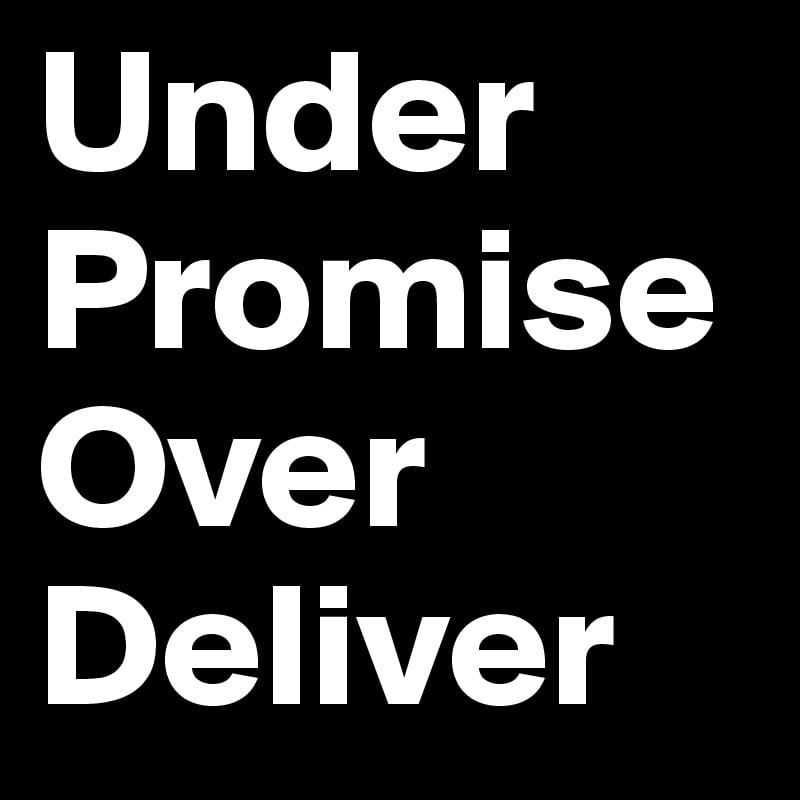
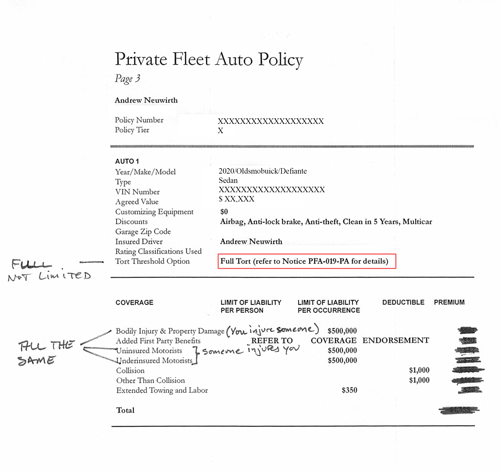
 Insurance companies lend you umbrellas when the sun is shining, but want them back the minute it begins to rain. This quote is sometimes attributed to Mark Twain regarding bankers, but in my view applies equally to my insurance company opponents. Did your rates plummet when you were not driving during the pandemic? No, they did not. Why not? Because it would hurt the insurers.
Insurance companies lend you umbrellas when the sun is shining, but want them back the minute it begins to rain. This quote is sometimes attributed to Mark Twain regarding bankers, but in my view applies equally to my insurance company opponents. Did your rates plummet when you were not driving during the pandemic? No, they did not. Why not? Because it would hurt the insurers.